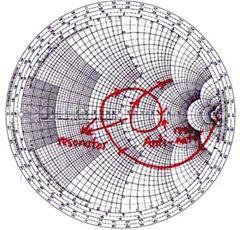

#Antenna smith chart series
Parallel LC, in parallel with the antennaĬircuits like a series LC filter are not useful, as they will have a stop band. Typical circuit topologies are shown in the table below: The goal is to ensure that the (antenna + impedance matching network) equivalent impedance matches the input impedance seen at the inlet of the transmission line. If taking the circuit-based approach, there are several options for impedance matching techniques in antennas. Although 50 Ohms on-die termination is often applied or is configurable in devices with an integrated RF transceiver, it doesn’t mean there will be perfect impedance matching. Instead, the input impedance needs to be matched to the transmitter’s output impedance so that the return loss (S11) can be reduced as much as possible at the antenna input and at the feedline input. In addition, the antenna and its matching network might connect to a short feedline, so the input impedance of the feedline may not be the line’s characteristic impedance. The result is that the design needs to be fabricated smaller, which creates an impedance mismatch. For other antennas, such as a printed antenna, it may be difficult to design the antenna to perfectly hit a 50 Ohm target impedance the traces might be very wide or the antenna may take up board space. Some antennas, such as chip antennas, have either low or high impedance when fabricated. The need for impedance matching techniques in antennas comes from the fact that antenna impedances are not always 50 Ohms. Impedance Matching Techniques in Antennas: Defining Impedance Matching Requirements Starting from a filtration perspective is the easiest impedance matching technique in antennas or other RF circuit elements. Impedance matching circuits are rather simple they act like filters that ensure an antenna’s feedline impedance matches the input impedance at the input port of the antenna. Impedance matching techniques for antennas are intended to ensure maximum power transfers into the antenna so that the element can radiate strongly.Īntenna impedance matching involves matching the input impedance at the end of the antenna’s feedline to the feedline’s characteristic impedance.įilter circuits are normally used, as they can be configured to provide specific impedance right at the desired transmission frequency.Īlthough antennas come in a variety of shapes and sizes, they have one thing in common: they need to have impedance matching enforced at the end of the feedline to ensure maximum power transfer into the load.


 0 kommentar(er)
0 kommentar(er)
